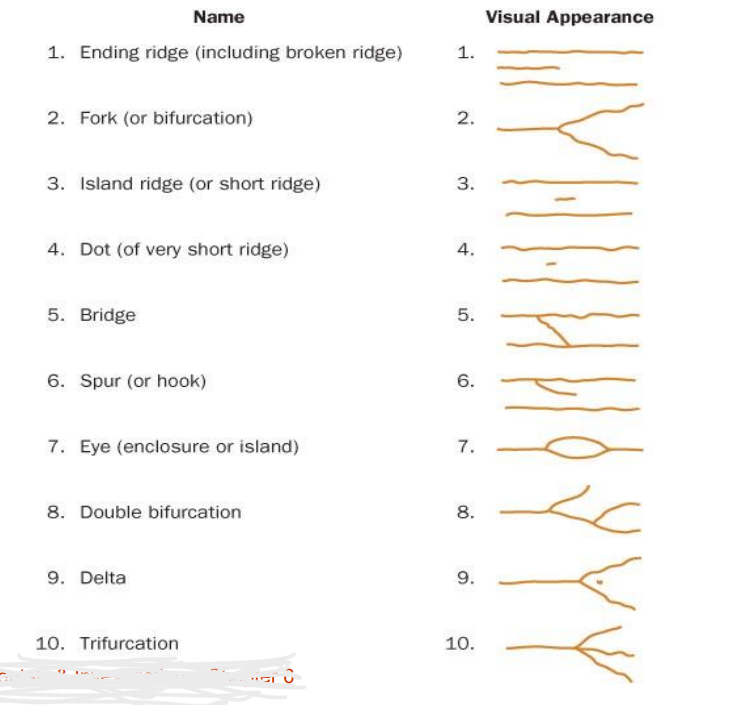Chapter 6 Study Guide: Fingerprint
Chapter 6 Study Guide: Fingerprint
1. Summarize the history of fingerprinting.
Ancient Babylon (1792–1750 B.C.): Clay tablet fingerprints used in contracts.
Ancient China: Fingerprints and palm prints on documents.
1684: First recorded study of hand patterns.
1823: Jan Evangelist Purkinje described nine fingerprint patterns.
1856: Sir William Herschel discovered fingerprints don't change with age.
1999: IAFIS (Integrated Automated Fingerprint Identification System) introduced.
2011: FBI's NGI (Next Generation Identification) launched.
2014: NGI added facial recognition.
2019: RISC (Repository of Individuals of Special Concern) developed.
2. Describe fingerprints and how they are formed.
Formed in the 10th week of gestation in the basal layer of the skin.
Caused by friction ridges, raised skin areas arranged in patterns.
These ridges leave marks when pressed on objects and are unique to individuals.
It can only be altered by permanent dermal damage (e.g., scarring).
3. Describe different characteristics and types of fingerprint patterns.
Types of fingerprints:
Patent: visible prints (e.g., blood, ink).
Plastic: impressions in soft material (e.g., clay).
Latent: invisible prints formed by sweat/oil.
Ridge patterns:
Loops (most common)
Whorls
Arches
Minutiae details help match fingerprints (e.g., ridge ending, bifurcation).
4. Describe proper procedures for collecting and documenting fingerprints.
CSIs are trained to:
Identify where to search.
Recognize fingerprint types.
Enhance and preserve prints.
Photograph in situ using alternate light sources (e.g., LED, lasers).
Lift and document prints: latent, patent, plastic, and suspect prints.
5. Explain how fingerprints are analyzed and their reliability.
Experts first assess the print quality and quantity.
Automated systems help with identification:
IAFIS, NGI, RISC.
Results must be double-checked to avoid examiner bias.
Standardization of courtroom language and methods is recommended.
Despite rare attempts to alter prints (e.g., John Dillinger), fingerprints are still reliable.
6. Discuss advances that have improved fingerprint reliability.
New technologies improve:
Speed
Accuracy
Digital scanning
Molecular fingerprinting (including trace DNA)
Fingerprint scanners are now handheld.
Analysis has become faster, more objective, and more reliable.
7. What chemicals are used to visualize latent prints on paper, plastics, glass, skin, wood, styrofoam, cardboard, and unpainting surfaces.
Surface | Chemical(s) Used |
|---|---|
Paper | Ninhydrin, Iodine Fuming |
Plastics | Cyanoacrylate Vapor |
Glass | Cyanoacrylate Vapor |
Skin | Iodine Fuming |
Wood | Silver Nitrate |
Styrofoam | Silver Nitrate |
Cardboard | Iodine Fuming |
Unpainted Surfaces | Silver Nitrate |
8. Summary of Fingerprinting (from slideshow)
Friction ridges secrete sweat/oils, leaving latent prints.
Prints are primarily latent at crime scenes.
Patterns: loops, whorls, arches.
Minutiae: fine ridge details used for identification.
Fingerprints are unique and nearly impossible to erase permanently.
Digital/automated systems improve fingerprint-matching speed and reliability.
Key Vocabulary Terms
Term | Definition |
|---|---|
Arch | Fingerprint pattern with ridges entering one side and exiting the other without a delta. |
Biometrics | Measuring and analyzing physical characteristics (e.g., fingerprints) to identify individuals. |
Core | Center of a loop or whorl fingerprint pattern. |
Delta | Triangular ridge pattern found in loop and whorl patterns. |
Fingerprint | The impression left by friction ridge skin on a surface. |
Integrated Automated Fingerprint Identification System (IAFIS) | National fingerprint database developed by the FBI. |
Latent Fingerprint | Hidden fingerprints are made visible through powders or chemicals. |
Loop | Fingerprint pattern where ridges enter and exit the same side; has one delta. |
Minutiae | Specific ridge characteristics used for fingerprint identification. |
Patent Fingerprint | Visible fingerprints are left by a substance such as blood, ink, or grease. |
Plastic Fingerprint | Impression is left in a soft material such as clay or wax. |
Ridge Count | Number of ridges between the core and delta. |
Ridge Pattern | General shape/form of ridges: loop, whorl, or arch. |
Ten Print Card | Form used to collect fingerprints from a person using all 10 fingers. |
Whorl | Circular or spiral fingerprint pattern that includes at least two deltas. |
Minutiae Fingerprint Analysis Patterns

more defined
Name | Visual Appearance |
|---|---|
Ridge Ending | A ridge that ends abruptly. |
Fork (Bifurcation) | A single ridge that splits into two. |
Island (Short Ridge) | A short ridge segment not connected to others. |
Dot | A very small ridge point. |
Bridge | A small ridge connecting two longer ridges. |
Spur (Hook) | A ridge that branches off and ends quickly. |
Eye | A ridge loop that forms an enclosed circle or oval. |
Double Bifurcation | A ridge that splits into two branches, each of which splits again. |
Delta | A triangular region formed by ridge patterns. |
Trifurcation | A single ridge that splits into three branches. |
What chemicals are used to visualize latent prints?
Chemical | Uses | Application | Safety | Reaction | Latent Print |
|---|---|---|---|---|---|
Ninhydrin | Detects amino acids in sweat | Sprayed/dipped on paper | Use gloves; may irritate the skin or lungs | Purple-blue color reaction with amino acids | Visible on paper |
Cyanoacrylate Vapor | Plastic, metal, glass | Heated in the chamber to create vapor | Ventilate; avoid inhalation | White polymer on fingerprint residue | Visible on non-porous surfaces |
Silver Nitrate | Wood, styrofoam, unpainted surfaces | Spray then expose to light | Stains skin and fabric; handle with care | Reacts with salt to form gray-black silver chloride | Visible on porous surfaces |
Iodine Fuming | Paper, cardboard, skin | Heated to release iodine vapors | Toxic fumes; use hood | Brown temporary print; reacts with oils/fats | Must be photographed quickly |
types of prints